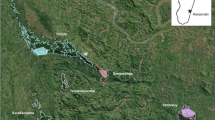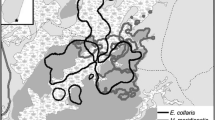Abstract
I present results from a comparative field study on the feeding behavior of the gregarious Avahi occidentalis and the solitary-but-social Lepilemur edwardsi to evaluate hypotheses relating to social organization and food resources. While Avahi and Lepilemur are both nocturnal, have comparable body weights and positional behaviors, and are both folivorous, they differ in their social organization. Therefore, they present an ideal model for assessing food resource characteristics through comparisons of food selection in both species with regard to forest composition. The monogamous Avahi tend to select under-represented resources. They are repeatedly exploited, which suggests that their location must be known. It is worthwhile and probably imperative to defend those resources. Such defense imposes ranging limitations on male Avahi. Females may prefer familiar mates that will share their knowledge of resource location and defend the resources. A stable monogamous pattern could be the optimal strategy. In contrast, food selection by Lepilemur is based on common resources to a higher degree, but they show a lower degree of exploitation. Lepilemur males would be less restricted and could potentially opt for a different strategy, e.g., a dispersed harem. It is unclear whether this strategy is realized or not. I discuss other possible correlates of monogamy—infanticide protection, predation avoidance—but the gregarious pattern in Avahi may best be seen as a retention, and its nocturnal activity as a secondary adaptation.
Similar content being viewed by others
REFERENCES
Barlow, G. W. (1987). Monogamy in relation to resources. In Slobodchikoff, C. N. (ed.), The Ecology of Social Behavior, Academic Press, New York, pp. 55–77.
Brower, J. E., Zar, J. H., and von Ende, C. N. (1990). Field and Laboratory Methods for General Ecology (3rd ed.), Wm. C. Brown Publishers, Dubuque (USA).
Charles-Dominique, P., and Hladik, C. M. (1971). Le Lepilémur du sud de Madagascar: Ecologie, alimentation et vie sociale. Terre et Vie 1: 3–66.
Charles-Dominique, P., and Petter, J.-J. (1980). Ecology and social life of Phaner furcifer. In Charles-Dominique, P., Cooper, H. M., Hladik, A., Hladik, C. M., Pages, E., Pariente, G. F., Petter-Rousseaux, A., Petter, J.-J., and Schilling, A. (eds.), Nocturnal Malagasy Primates, Academic Press, New York, pp. 75–96.
Clutton-Brock, T. H. (1989). Mammalian mating systems. Proc.Roy. Soc. Lond.B 236: 339–372.
Clutton-Brock, T. H., and Harvey, P. H. (1978). Mammals, resources and reproductive strategies. Nature London 273: 191–195.
Crook, J. H., and Gartlan, J. S. (1966). Evolution of primate societies. Nature London 210: 1200–1203.
Curtis, D. J. (1997). The Mongoose Lemur (Eulemur mongoz): A Study in Behaviour and Ecology. Ph.D. Thesis, University of Zurich, Zurich (Switzerland).
Davies, N. B. (1991). Mating systems. In Krebs, J. R., and Davies, N. B. (eds.), Behavioural Ecology (3rd ed.), Blackwell Scientific Publications, Oxford, pp. 263–294.
Dunbar, R. I. M. (1988). Primate Social Systems. Croom Helm, London.
Eisenberg, J. F., Muckenhirn, N. A., and Rudran, R. (1972). The relation between ecology and social structure in primates. Science 176: 863–874.
Fietz, J. (1999). Monogamy as a rule rather than exception in nocturnal lemurs: The case of the fat-tailed dwarf lemur, Cheirogaleus medius. Ethology 105: 259–272.
Fuentes, A. (1999). Re-evaluating primate monogamy. Am. Anthropol. 100: 890–907.
Ganzhorn, J. U. (1988). Food partitioning among Malagasy primates. Oecologia (Berlin) 75: 436–450.
Ganzhorn, J. U. (1993). Flexibility and constraints of Lepilemur ecology. In Kappeler, P. M., and Ganzhorn, J. U. (eds.), Lemur Social Systems and Their Ecological Basis, Plenum Press, New York, pp. 153–165.
Ganzhorn, J. U., Abraham, J. P., and Razanahoera-Rakotomalala, M. (1985). Some aspects of the natural history and food selection of Avahi laniger. Primates 26: 452–463.
Ganzhorn, J. U., and Kappeler, P. M. (1996). Lemurs of the Kirindy forest. Primate Report (Special Issue) 44(1): 257–274.
Harcourt, C. (1991). Diet and behavior of a nocturnal lemur, Avahi laniger, in the wild. J. Zool. 223: 667–674.
Harcourt, C., and Thornback, J. (1990). Lemurs of Madagascar and the Comoros. The IUCN Red Data Book. IUCN, Gland (Switzerland) and Cambridge (UK).
Harcourt, C. S., and Nash, L. (1986). Social organization of galagos in Kenyan coastal forests: I. Galago zanzibaricus. Am. J. Primatol. 10: 339–355.
Hladik, C. M. (1978). Adaptive strategies of primates in relation to leaf-eating. In Montgomery, G.G. (ed.), ArborealFolivores, Smithsonian Institution Press, Washington DC, pp. 373–395.
Hladik, C.M. (1980). The dry forest of the West Coast of Madagascar: Climate, phenology, and food available for prosimians. In Charles-Dominique, P., Cooper, H. M., Hladik, A., Hladik, C. M., Pages, E., Pariente, G. F., Petter-Rousseaux, A., Petter, J.-J., and Schilling, A. (eds.), Nocturnal Malagasy Primates, Academic Press, New York, pp. 3–40.
Hladik, C. M., and Charles-Dominique, P. (1974). The behavior and ecology of the sportive lemur (Lepilemur mustelinus) in relation to its dietary peculiarities. In Martin, R. D., Doyle, G. A., and Walker, A. C. (eds.), Prosimian Biology, Duckworth, London, pp. 23–37.
Hladik, C. M., Charles-Dominique, P., and Petter, J.-J. (1980). Feeding strategies of five nocturnal prosimians in the dry forest of the west coast of Madagascar. In Charles-Dominique, P., Cooper, H. M., Hladik, A., Hladik, C. M., Pages, E., Pariente, G. F., Petter-Rousseaux, A., Petter, J.-J., and Schilling, A. (eds.), Nocturnal Malagasy Primates, Academic Press, New York, pp. 41–73.
Janson, C. H. (1992). Evolutionary ecology of primate social structure. In Smith, E. A., and Winterhalder, B. (eds.), Evolutionary Ecology and Human Behavior, Aldine de Gruyter, New York, pp. 95–130.
Jolly, A. (1998). Pair-bonding, female aggression and the evolution of lemur societies. Folia Primatol. 69(suppl. 1): 1–13.
Kappeler, P.M. (1997). Determinants of primate social organization: comparative evidence and new insights from Malagasy lemurs. Biol. Rev. Camb. Soc. Zool. 72: 111–151.
Kleiman, D. G. (1977). Monogamy in mammals. Quart. Rev. Biol. 52: 39–69.
Krebs, C. J. (1989). Ecological Methodology. Harper and Row, New York.
Martin, R. D. (1990). Primate Origins and Evolution: A Phylogenetic Reconstruction. Chapman and Hall, London.
Martin, R. D., Chivers, D. J., MacLarnon, A. M., and Hladik, C. M. (1985). Gastrointestinal allometry in primates and other mammals. In Jungers, W. L. (ed.), Size and Scaling in Primate Biology, Plenum Press, New York, pp. 61–89.
Mitani, J. C., and Rodman, P. S. (1979). Territoriality: The relation of ranging pattern and home range size to defendability, with an analysis of territoriality among primate species. Behav. Ecol. Sociobiol. 15: 241–251.
Müller, A. E. (1998). A preliminary report on the social organization of Cheirogaleus medius (Cheirogaleidae; Primates) in north-west Madagascar. Folia Primatol. 69: 160–166.
Müller, A. E. (1999a). Social organization of the fat-tailed dwarf lemur (Cheirogaleus medius) in northwestern Madagascar. In Rakotosamimanana, B., Rasamimanana, H., Ganzhorn, J. U., and Goodman, S. (eds.), New Directions in Lemur Studies, Plenum Press, New York, pp. 139–158.
Müller, A. E. (1999b). Aspects of social life in the fat-tailed dwarf lemur (Cheirogaleus medius): Inferences from body weights and trapping data. Am. J. Primatol. 49: 265–280.
Müller, A. E., and Thalmann, U. (2000). Origin and evolution of primate social organisation: A reconstruction. Biol. Rev. Cambridge Philos. Soc. 75: 405–435.
Nash, L. T. (1998). Vertical clingers and sleepers: Seasonal influences on the activities and substrate use of Lepilemur leucopus at Beza Mahafaly Special Reserve, Madagascar. Folia Primatol. 68 (suppl. 1): 204–217.
Overdorff, D. J. (1996). Ecological correlates to social structure in two lemur species in Madagascar. Am. J. Phys. Anthropol. 100: 487–506.
Overdorff, D. J. (1998). Are Eulemur species pair-bonded? Social organization and mating strategies in Eulemur fulvus rufus from 1988–1995 in southeast Madagascar. Am. J. Phys. Anthropol. 105: 153–166.
Petter, J.-J., Albignac, R., and Rumpler, Y. (1977). Mammifè res Lémuriens (Primates Prosimiens). ORSTOM/CNRS, Paris.
Pietsch, T. Geschlechtsabhängige Strategien im Ernährungsverhalten und der Habitatnutzung bei braunen Wieselmakis (Lepilemur ruficaudatus). Diploma thesis, University of Hamburg, Hamburg (Germany).
Razanahoera, M. (1988). Comportement alimentaire de deux espè ces sympatriques dans la Forê t d'Ankarafantsika (nord-ouest de Madagascar): Lepilemur edwardsi et Avahi laniger (lémuriens nocturnes). In Rakotovao, L., Barre, V., and Sayer, J. (eds.), L'équilibre des Ecosystè mes Forestiers à Madagascar: Actes d'un Séminaire International, IUCN/UCIN, Gland (Switzerland) and Cambridge, (UK), pp. 96–99.
Robbins, C. T. (1993). Wildlife Feeding and Nutrition (2nd ed.). Academic Press, New York.
Rodman, P. S. (1987). Resources and group sizes in primates. In Slobodchikoff, C. N. (ed.), The Ecology of Social Behavior, Academic Press, New York, pp. 83–108.
Roth, O. (1996). Ecology and Social Behavior of theWoolly Lemur (Avahi laniger), a Nocturnal Malagasy Prosimian. Diploma thesis, University of Basel, Basel (Switzerland).
Rowell, T. E. (1988). The social system of guenons, compared with baboons, macaques, and mangabeys. In Gautier-Hion, A., Bourliére, F., Gautier, J.-P., and Kingdon, J. (eds.), A Primate Radiation: Evolutionary Biology of the African Guenons, Cambridge University Press, Cambridge, pp. 439–451.
Russell, R. J. (1977). The Behavior, Ecology and Environmental Physiology of a Nocturnal Primate, Lepilemur mustelinus (Strepsirhini, Lemuriformes, Lepilemuridae). Ph.D. Thesis, Duke University, Durham (USA).
Rutberg, A. T. (1983). The evolution of monogamy in primates. J. Theor. Biol. 104: 93–112.
Smith, E. P. (1982). Niche breadth, resource availability, and inference. Ecology 63: 1675–1681.
Smuts, B. B., Cheney, D. L., Seyfarth, R. M., Wrangham, R. W., and Struhsaker, T. T. (eds.). (1987). Primate Societies. University of Chicago Press, Chicago.
Sokal, R. R., and Rohlf, F. J. (1981). Biometry.W. H. Freeman and Co., New York.
Sorg, J.-P. (1996). Vernacular and scientific names of plants of the Morondava region. Primate Report (Special Issue) 44(1): 339–346.
Tattersall, I. (1982). The Primates of Madagascar, Columbia University Press, New York.
Terborgh, J., and Janson, C. H. (1986). The socioecology of primate groups. Annual Rev. Ecol. Syst. 17: 111–135.
Thalmann, U. (1998). Sociality in the nocturnal lemurs Avahi and Lepilemur: A comparison. Abstract 064, XVII. Congress of the International Primatological Society, University of Antananarivo, Antananarivo (Madagascar).
Van Schaik, C. P. (1983). Why are diurnal primates living in groups? Behavior 87: 120–140.
Van Schaik, C. P., and Dunbar, R. I. M. (1990). The evolution of monogamy in large primates: A new hypothesis and some crucial tests. Behavior 115: 30–62.
Van Schaik, C. P., and Van Hooff, J. A. R. A. M. (1983). On the ultimate causes of primate social systems. Behaviour 85: 91–117.
Warren, R. D., and Crompton, R. H. (1997). A comparative study of the ranging behaviour, activity rhythms and sociality of Lepilemur edwardsi (Primates, Lepilemuridae) and Avahi occidentalis (Primates, Indriidae) at Ampijoroa, Madagascar. J. Zool. 243: 397–415.
Wickler, W., and Seibt, U. (1983). Monogamy: An ambiguous concept. In Bateson, P. (ed.), Mate Choice, Cambridge University Press, Cambridge, pp. 33–50.
Wittenberger, J. F., and Tilson, R. L. (1980). The evolution of monogamy. Annual Rev. Ecol. Syst. 11: 197–232.
Wright, P. C. (1986). Ecological correlates of monogamy in Aotus and Callicebus. In Lee, P. C., and Else, J. G. (eds.), Primate Ecology and Conservation (Vol. 2), Cambridge University Press, Cambridge, pp. 159–167.
Zar, J. H. (1984). Biostatistical Analysis (2nd ed.). Prentice Hall Inc., Englewood Cliffs, New Jersey.
Author information
Authors and Affiliations
Rights and permissions
About this article
Cite this article
Thalmann, U. Food Resource Characteristics in Two Nocturnal Lemurs with Different Social Behavior: Avahi occidentalis and Lepilemur edwardsi. International Journal of Primatology 22, 287–324 (2001). https://doi.org/10.1023/A:1005627732561
Issue Date:
DOI: https://doi.org/10.1023/A:1005627732561




